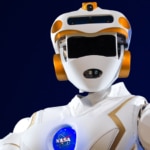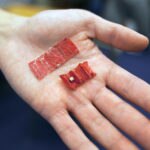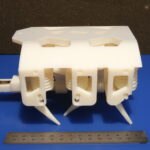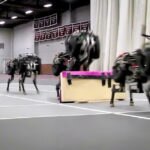Digestible, transparent and animal-shaped robots, technological trends at MIT
Advances in mechanics, manufacturing techniques and artificial intelligence are giving way to increasingly sophisticated and specialized robots. These are some examples of the next generation of robotics that are being developed in MIT laboratories.

Soft and rigid; humanoid and animal form; origami and 3D print-outs: robots are adopting increasingly surprising forms. Research with new materials and structures is giving way to new formats that are often well beyond the traditional concept of a “robot” in order to respond to specific needs, like transporting pharmaceuticals inside the human body or rescue tasks.
Digestible origami robots
For several years at the MIT Computer Science and Artificial Intelligence Laboratory (CSAIL) in the United States, they have been studying how to make robots that, like little paper birds, can be folded and unfolded, changing shape and size. Specifically, the engineering team Daniela Rus, makes robots that “unfold” after certain triggers, like temperature or water, to acquire new forms once they are in the appropriate place. This year, they presented their advances in a miniature origami robot designed to be swallowed by a person unfolded and packaged in a capsule. Once it reaches the stomach, the robot unfolds its mechanism and can be manipulated by the engineers from the outside to perform surgical operations or transport pharmaceuticals.

Ingestible origami robot developed at MIT. - Melanie Gonick/MIT
Researchers have been able to successfully test the mechanism in an artificial stomach, in which the small robot was able to remove a button cell battery stuck to the wall of the stomach and take it away (according to the researchers, 3,500 button cell batteries are swallowed each year in the US alone).
Transparent gel robots
Also with possible applications in the medical field, engineers from MIT have developed a series of hydrogel robots that move when pumping water inside their flexible rubber circuits. Researchers think they may serve to create a “soft” surgical equipment that allows effectively handling delicate tissues and organs. In addition, given that the hydrogel is mostly made up of water, they consider it to be a safe material to be used in the medical field.
Another characteristic of these hydrogel robots is that they are practically transparent, and because they are mostly made up of water, they are perfectly camouflaged in a water environment. In an experiment, researchers were able to use them to catch and release fish without being seen, and they think this quality may be useful for exploring oceans.

Made from hydrogel, these robots may one day assist in surgical operations, evade underwater detection. - Hyunwoo Yuk/MIT Soft Active Materials Lab
This development may be included within soft robotics, a new generation of robots made with more flexible, lighter and even biodegradable materials that imitate and greatly expand the capacities of the natural organisms and have a broad potential for the future of medicine. The Professor from the University of Bristol, Jonathan Rossiter, one of the top international experts in soft robotics and intelligent materials, dedicated a chapter to this trend in the book published by BBVA 'The Next Step: Exponential Life'. The book, part of the BBVA OpenMind initiative, can be downloaded for free in several electronic formats.
| Download complete book | |||
|
|||
Simultaneously liquid and solid robots
One of the disadvantages of working with robots is that making them is a costly, slow and complex process—something that 3D printing is changing little by little. Another team from MIT’s CSAIL laboratory has developed a pioneer technique to print robots in 3D with liquid and solid materials at the same time.

This 3-D hexapod robot moves via a single motor, which spins a crankshaft that pumps fluid to the robot’s legs. - Robert MacCurdy/MIT CSAIL
The result is a robot that is printed “ready to use”, which does not require assembly and only needs a motor and battery after being printed in order to start functioning. The technique—dubbed “printable hydraulics”—allows the robot to move thanks to an internal hydraulic pump mechanism that functions with the liquid already “printed” inside the structure. Here you can see how the six-legged robot moves thanks to the 12 “ready-to-wear” hydraulic pumps.
Rescue robots that imitate animals
In the next five to ten years, rescue robots in the form of animals could be a reality, according to the Associate Professor of Mechanical Engineering at MIT, Sangbae Kim. This engineer works with his team from the Biomimetic Robotics Lab to replicate the biomechanics of animals and the capacity to make human decisions in order to create robots capable of doing physical work, like opening doors, breaking through walls and removing debris.
One of his most famous creations is the cheetah-robot, a four-legged machine that surpasses the capacities of the original species and is capable of identifying and jumping over obstacles autonomously.

MIT researchers have trained their robotic cheetah to see and jump over hurdles as it runs —making this the first four-legged robot to run and jump over obstacles autonomously. - Haewon Park, Patrick Wensing, and Sangbae Kim.
Humanoid robots to explore Mars
If the inspiration for rescue robots comes from the world of animals, the inspiration that has served as a model for one of the future explorers of the red planet, Valkyrie, comes from humans. This robot is one of the most sophisticated humanoid robots to date. It is 1.80 meters tall, weighs 136 kilos and is equipped with four cameras and more than 200 sensors. It is capable of walking, turning door knobs, getting up after falling and autonomously doing many highly complex tasks.

Researchers at MIT's Computer Science and Artificial Intelligence Laboratory will test and develop the "Valkyrie" for future space missions. - NASA
It was initially designed for rescue tasks, but later NASA decided to test its capacity for even more hostile environments, such as special missions. To do so, it commissioned MIT researchers to design algorithms to train the robot for the next Space Robotics Challenge. This competition looks for the best autonomous robots in the world capable of helping or even replacing humans in extremely dangerous special missions, like future expeditions to Mars.


